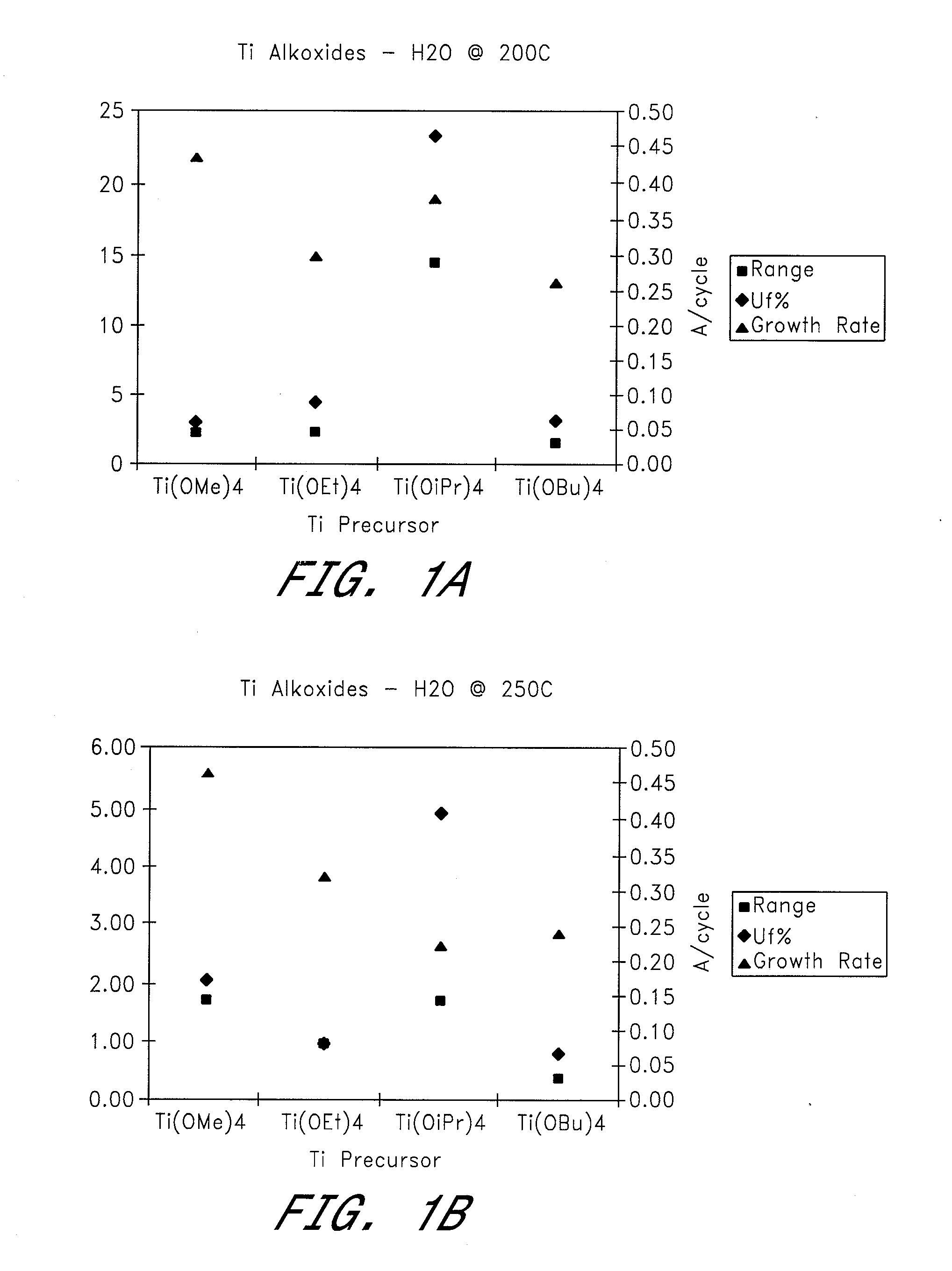Metal oxide films
a technology of metal oxide films and oxides, applied in the direction of chemical vapor deposition coatings, crystal growth processes, coatings, etc., can solve the problems of difficult oxygen source ald using water as oxygen source, difficulty in forming hydroxides of alkali earth metal precursors,
- Summary
- Abstract
- Description
- Claims
- Application Information
AI Technical Summary
Problems solved by technology
Method used
Image
Examples
example 1
[0050] Four different titanium alkoxides were tested as metal precursors in ALD reactions to deposit TiO2 using H2O and O3 as oxygen sources. Films were deposited at temperatures of 100-300° C. (see FIGS. 1a-g).
[0051] Reactions Using H2O as the Oxygen Source Material:
[0052] a) TiO2 films were deposited at 200-300° C. by ALD using alternate pulses of Ti(OEt)4 as the titanium precursor and water as the oxidant. The growth rate increased from 0.30 to 0.39 Å / cycle with increasing temperature. The film uniformity (Uf % 1σ) varied between 0.98 and 4.43, with the best uniformity being obtained at a deposition temperature of 250° C.
[0053] b) TiO2 films were deposited by ALD at deposition temperatures of 200-300° C., using alternating pulses of Ti(OiPr)4 as the titanium precursor and water as the oxidant. Growth rates were about 0.22-0.42 Å / cycle, with the lowest value being obtained at 250° C. and the highest at 300° C. Film uniformity (Uf % 1σ) at these temperatures was 4.84 and 6.84 re...
example 2
[0124] SrTiO3 films were grown in a flow-type F-120 ALE reactor (Mikrokemia Oy) at a temperature of 325° C. The strontium precursor used was the THF adduct of bis(triisopropylcyclopentadienyl) strontium, Sr(C5(iC3H7)3H2)THFGp, in which p=0-2 and THF is tetrahydrofuran, and which was vaporized in the reactor by heating it to a temperature of 100° C. The titanium precursor used was titanium tetraisopropoxide (Ti(O1C3H7)4), which was vaporized in the reactor at a temperature of 40° C. The oxygen source used was water, which was fed into the reactor from outside it. The growth of TiO2 from the said precursors has been described previously (Ritala et al., Chemistry of Materials 5 (1993) 1174).
[0125] The growth of SrTiO3 was implemented by using alternate Ti—O and Sr—O deposition cycles. The Ti—O cycle was made up of four steps: (i) an 0.6 s pulse of Ti(OiC3H7)4, an 0.5 s purge with inert nitrogen gas, (iii) an 0.6 pulse of H2O, and (iv) an 0.5 s purge with nitrogen gas. Respectively, th...
example 3
[0128] The process according to Example 1 was repeated using a growth temperature of 250° C. The films thus grown were amorphous, but they crystallized when they were heated in air at 500° C. for 60 min.
PUM
| Property | Measurement | Unit |
|---|---|---|
| temperature | aaaaa | aaaaa |
| temperatures | aaaaa | aaaaa |
| pressure | aaaaa | aaaaa |
Abstract
Description
Claims
Application Information
 Login to View More
Login to View More - R&D
- Intellectual Property
- Life Sciences
- Materials
- Tech Scout
- Unparalleled Data Quality
- Higher Quality Content
- 60% Fewer Hallucinations
Browse by: Latest US Patents, China's latest patents, Technical Efficacy Thesaurus, Application Domain, Technology Topic, Popular Technical Reports.
© 2025 PatSnap. All rights reserved.Legal|Privacy policy|Modern Slavery Act Transparency Statement|Sitemap|About US| Contact US: help@patsnap.com



